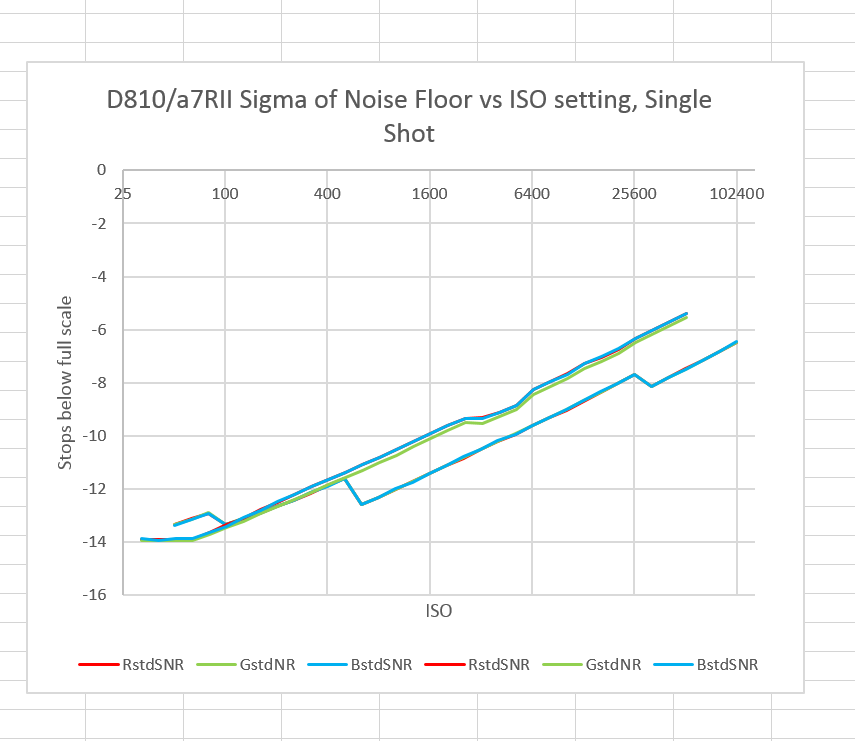Some of you asked for this:
The red, green, and blue raw channels are all on top of each other. The D810 curve is the one that starts at ISO 32 and goes to ISO 50K. The a7RII curve is the one that starts at ISO 50 and goes to ISO 100K. These curves are not corrected for resolution differences, and thus shows the a7RII at a slight disadvantage.
The disadvantage is log2(sqrt(42/36)) = 0.11 stops.
Isn’t it amazing that you can just stick that in your browser and get the answer!
What’s the interpretation?
- The D810 has better base ISO read noise and EDR.
- The cameras are neck and neck at ISO 100.
- At ISO 640, the a7RII pulls ahead and stays ahead.
- The a7RII improvement at ISO 32000 and above is bogus, accomplished through in-camera spatial low-pass filtering.


Love the images on the banner. Are they posted anywhere where I can see them full screen?
Not full screen, but you can see many more and larger one in the gallery section of the web site.
http://www.kasson.com/galleries/index.php
Jim
Hi, a Chinese tester seems to found something interesting, at 1/60s shutter, the A7R2 is found to have better dynamic range than the D810 as shown in the below picture:
http://goo.gl/G2Mx1Z
The data seem to be in agreement with yours. But at 30s shutter, they found that the situation is reversed and the A7R2 seems to lag a lot, due to severe color noise:
http://goo.gl/wSuG9E
Can you confirm this or any comment?
Thanks!
The first image seems not to refer to an 810.
The D810 curve is the one that starts at ISO 32 and goes to ISO 50K. The a7RII curve is the one that starts at ISO 50 and goes to ISO 100K.
Your test doesn’t say anything about real DR because the camera has automatic DR optimizer for hardware based file size reduction that even firmware update can’t alter. It’s auto changed between 12 – 13,5 EV stop at best.
If you’re talking sbout Sony rsw compression, it doesn’t affect dynamic range in cameras that have as much read noise as the a7x ones do.
http://blog.kasson.com/?s=sony+raw+compression
If by “real” dynamic range you mean photographic dynamic range, I’ll be publishing those numbers shortly.
Jim
If you add the “disadvantage” the A7RII has, wouldn’t that actually put it ahead of the D810 at ISO 100?
Good point. But we should remember that looking at such small differences, while interesting, doesn’t significantly affect real photography (as opposed to testing).
Jim
Could the kinks on the AR7II curve be related to the NR in RAW files?
The kink above ISO 25600 is. The one at the ISO 500 to ISO 640 transition is most likely the result of a change of conversion gain by switching out a capacitor in parallel with the photodiodes.
At what point do these minute and miniscule differences become completely unimportant to the end product and thus are an honest waste of time to even test? Please don’t take offense, I appreciate the time and data given, I just think we’re splitting hairs here so close that it has no practical value.
If you don’t care about the results, I suggest you find a more profitable use of your time. Modern cameras are remarkable photographic tools, and great photographs are made every day by people who neither know nor care how to get everything possible out of them.
Goodbye and good luck.
Jim